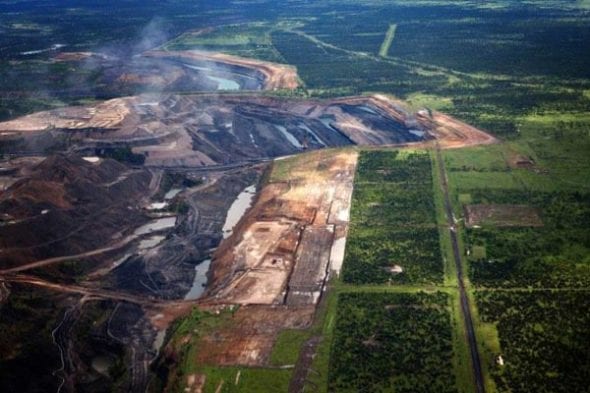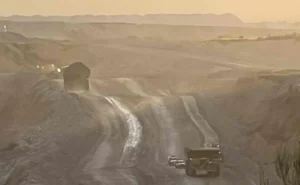Adani recently flagged that it is pinning its hopes for its beleaguered Carmichael thermal coal mine in Australia on growth in the Asia-Pacific market, even though the Australian government’s own resources forecaster is now painting a gloomy picture for coal exporters.
Recently the Indian-owned Adani Mining told the Guardian that the seaborne thermal coal demand had grown by 4.9 per cent over the last decade and optimistically proclaimed that “continued growth is forecast” which “will create opportunities for the Australian coal industry.”
The latest data from the Australian Government’s Department of Industry, Innovation and Science (DIIS) suggests Adani is dreaming.
It is worth noting that DIIS’s coal forecasts have long been upbeat about the future of Australian coal exports and were slow to recognise the profound implications of public revulsion in China, India and other Asian countries at air pollution.
While all estimates of future demand need to be treated with caution, it is worth noting that DIIS has also been slow to recognise the renewable energy revolution transforming the power generation industry.
DIIS data certainly show the dramatic growth in the seaborne thermal coal trade over the last decade.
However, over the next six years to 2023 DIIS sees a decline in the seaborne thermal coal market with a fall of 20 million tonnes by 2022 followed by an increase of 7 million tonnes in 2023.
If India cuts coal imports, what’s left for Adani?
Adani has proclaimed “there has been no change to our marketing strategy. India will remain the key market for Carmichael coal.”
However, DIIS is far less optimistic in its estimates of future Indian demand for thermal coal. Instead it estimates India’s thermal coal demand will gradually decline from the 152 million tonnes imported in 2017 to 140 million tonnes in 2023, a 1.3% annual decline.
The implications for Adani are even more pronounced, given the closure of the its 4600 megawatt Mundra power plant since February 2018 as unviable at current import coal prices.
Adani also told the Guardianthat “we are also targeting growth in demand for seaborne thermal coal from south-east Asia and continued strong demand from north Asia.”
While Asia remains one of the few potential growth centres for thermal coal globally, even here DIIS’s estimate of future demand is rather muted.
Instead of the “continued growth” Adani sees, DIIS estimates that total Asian thermal coal imports will gradually fall from 760 to 740 million tonnes a year between 2017 and 2023.
Even if Adani does proceed with its Carmichael mine, DIIS estimates the spot price of seaborne thermal coal (in real terms) will fall from US$97 a tonne in 2019 to US$71 tonne in 2023.
This estimated 27 per cent fall in market prices by 2023 is one of the reasons why Adani has found it impossible to find banks willing to stump up billions for its big-budget mine, railway and port project.
It is also worth noting DIIS’s estimate of the future spot price for thermal coal is based on the benchmark Newcastle 6,000 kcal coal. Adani’s Carmichael coal is a far lower quality product ranked at 4950 kcal and with 25–30 per cent ash content.
In the global market, high-ash, low-calorific-value coals sell at a discount to their higher quality counterparts, and rising pressures to deal with air pollution will only widen this discount gap over time.
All up, DIIS’s view of the global seaborne thermal coal market is far less rosy than Adani’s.
In short, DIIS estimates that over the 2018 to 2023 period the global seaborne thermal coal market will decline, demand will fall in both India and Asia and coal prices will decline in real terms.
In a declining market, competition for market share will be fierce given the high upfront capital cost and stranded asset nature of purpose built, long life rail and port infrastructure.
Existing global suppliers in countries such as Indonesia, Russia, South Africa, Canada and Colombia will all be looking to utilise existing mine and port infrastructure.
In Australia, the major producers in the NSW Hunter Valley will also remain major players in the regional market.
Adani has variously touted the Carmichael coal project as producing between 25 million and 60 million tonnes a year for export, a huge volume for a declining market to absorb.
As Adani’s coal would be low-quality coal and be produced at a high cost to cover the huge infrastructure costs, the project wouldn’t stand a chance in the global market.
Without a realistic business case for 25–60 million tonnes a year of low-grade coal, it is no surprise that Adani have yet any financial institutions or equity partners willing to be publicly associated with the project.
Bob Burton is the Editor of CoalWire, a weekly bulletin on global coal industry developments published by CoalSwarm. (You can sign up for it here.) Bob’s Twitter feed is @BobBurtonoz.












